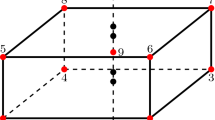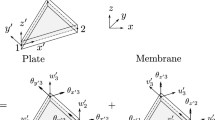Abstract
To overcome the issue of spurious maximum eigenfrequencies leading to small steps in explicit time integration, a recently proposed selective mass scaling technique, specifically conceived for 8-node hexahedral solid-shell elements, is reconsidered for application to layered shells, where several solid-shell elements are used through the thickness of thin-walled structures. In this case, the resulting scaled mass matrix is not perfectly diagonal. However, the introduced coupling is shown to be limited to the nodes belonging to the same fiber through the thickness, so that the additional computational burden is almost negligible and by far compensated by the larger size of the critical time step. The proposed numerical tests show that the adopted mass scaling leads to a critical time step size which is determined by the element in-plane dimensions only, independent of the layers number, with negligible accuracy loss, both in small and large displacement problems.























Similar content being viewed by others
References
Abed-Meraim F, Combescure A (2009) An improved assumed strain solid-shell element formulation with physical stabilization for geometric non-linear applications and elastic-plastic stability analysis. Int J Numer Methods Eng 80(13):1640–1686
Abed-Meraim F, T VD, Combescure A (2013) New quadratic solid-shell elements and their evaluation on linear benchmark problems. Computing 95(5):373–394
Askes H, Nguyen DCD, Tyas A (2011) Increasing the critical time step: micro-inertia, inertia penalties and mass scaling. Comput Mech 47(6):657–667
Cocchetti G, Pagani M, Perego U (2013) Selective mass scaling and critical time-step estimate for explicit dynamics analyses with solid-shell elements. Comput Struct 127:39–52
Cocchetti G, Pagani M, Perego U (2015) Selective mass scaling for distorted solid-shell elements in explicit dynamics: optimal scaling factor and stable time step estimate. Int J Numer Methods Eng 101(9):700–731
Flanagan D, Belytschko T (1984) Eigenvalues and stable time steps for the uniform strain hexaedron and quadilateral. J Appl Mech 51(1):35–40
Frangi A, Pagani M, Perego U, Borsari R (2010) Directional cohesive elements for the simulation of blade cutting of thin shells. Comput Modeling Eng Sci (CMES) 57(3):205
Hauptmann R, Schweizerhof K (1998) A systematic development of ‘solid-shell’ element formulations for linear and non-linear analyses employing only displacement degrees of freedom. Int J Numer Methods Eng 42(1):49–69
Hetherington J, Rodriguez-Ferran A, Askes H (2012) A new bipenalty formulation for ensuring time step stability in time domain computational dynamics. Int J Numer Methods Eng 90:269–286
Ibrahimbegovic A, Brank B, Courtois P (2001) Stress resultant geometrically exact form of classical shell model and vector-like parametrization of constrained finite rotations. Int J Numer Methods Eng 52:1235–1252
Macek RW, Aubert BH (1995) A mass penalty technique to control the critical time increment in explicit dynamic finite element analyses. Earthq Eng Struct Dyn 24(10):1315–1331
Meyers MA (1994) Dynamic behavior of materials. Wiley, New York
Naceur H, Shiri S, Coutellier D, Batoz JL (2013) On the modeling and design of composite multilayered structures using solid-shell finite element model. Finite Elem Anal Des 70–71:1–14
Olovsson L, Unosson M, Simonsson K (2004) Selective mass scaling for thin walled structures modeled with tri-linear solid elements. Comput Mech 34(2):134–136
Olovsson L, Simonsson K, Unosson M (2005) Selective mass scaling for explicit finite element analyses. Int J Numer Methods Eng 63(10):1436–1445
Pagani M, Reese S, Perego U (2014) Computationally efficient explicit nonlinear analyses using reduced integration-based solid-shell finite elements. Comput Methods Appl Mech Eng 268:141–159
Schwarze M, Reese S (2011) A reduced integration solid-shell finite element based on the EAS and the ANS concept: large deformation problems. Int J Numer Methods Eng 85(3):289–329
Sokolinsky VS, Shen H, Vaikhanski L, Nutt SR (2003) Experimental and analytical study of nonlinear bending response of sandwich beams. Compos Struct 60:219–229
Tan X, Vu-Quoc L (2005) Efficient and accurate multilayer solid-shell element: non-linear materials at finite strain. Int J 63(15):2124–2170
Tkachuk A, Bischoff M (2013a) Local and global strategies for optimal selective mass scaling. Comput Mech 53(6):1197–1207
Tkachuk A, Bischoff M (2013b) Variational methods for selective mass scaling. Comput Mech 52(3):563–570
Tkachuk A, Bischoff M (2015) Direct and sparse construction of consistent inverse mass matrices: general variational formulation and application to selective mass scaling. Int J Numer Methods Eng 101(6):435–469
Zukas JA (2004) Introduction to hydrocodes. Elsevier, Amsterdam
Acknowledgments
The financial support by Tetra Pak Packaging Solutions is kindly acknowledged.
Author information
Authors and Affiliations
Corresponding author
Rights and permissions
About this article
Cite this article
Confalonieri, F., Ghisi, A. & Perego, U. 8-Node solid-shell elements selective mass scaling for explicit dynamic analysis of layered thin-walled structures. Comput Mech 56, 585–599 (2015). https://doi.org/10.1007/s00466-015-1188-4
Received:
Accepted:
Published:
Issue Date:
DOI: https://doi.org/10.1007/s00466-015-1188-4




